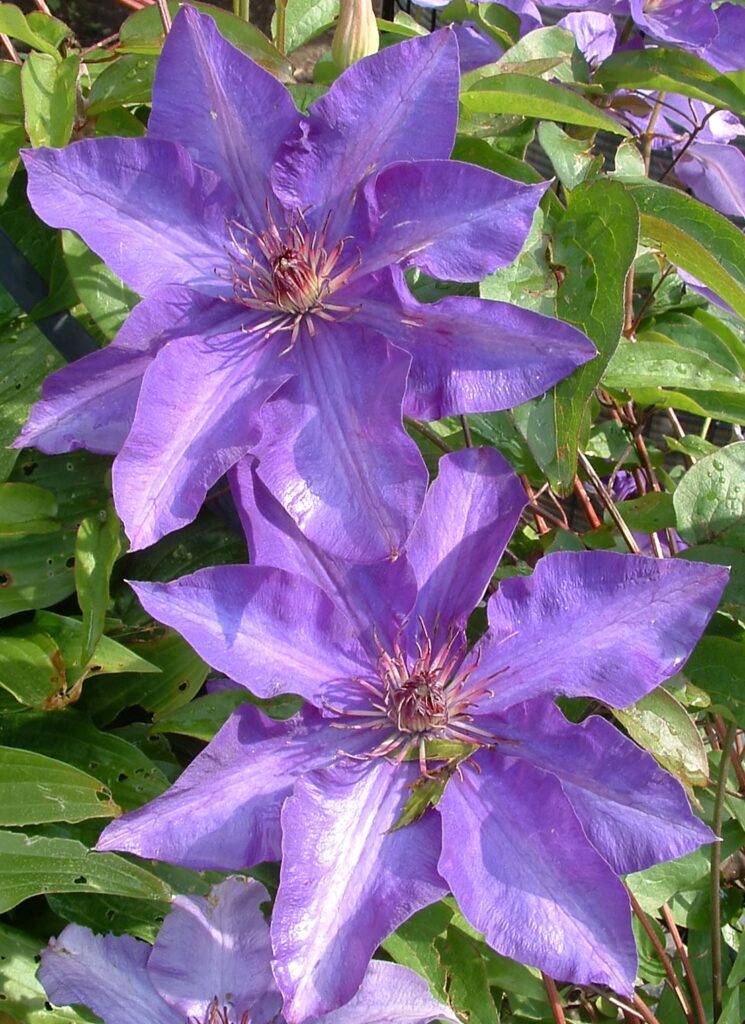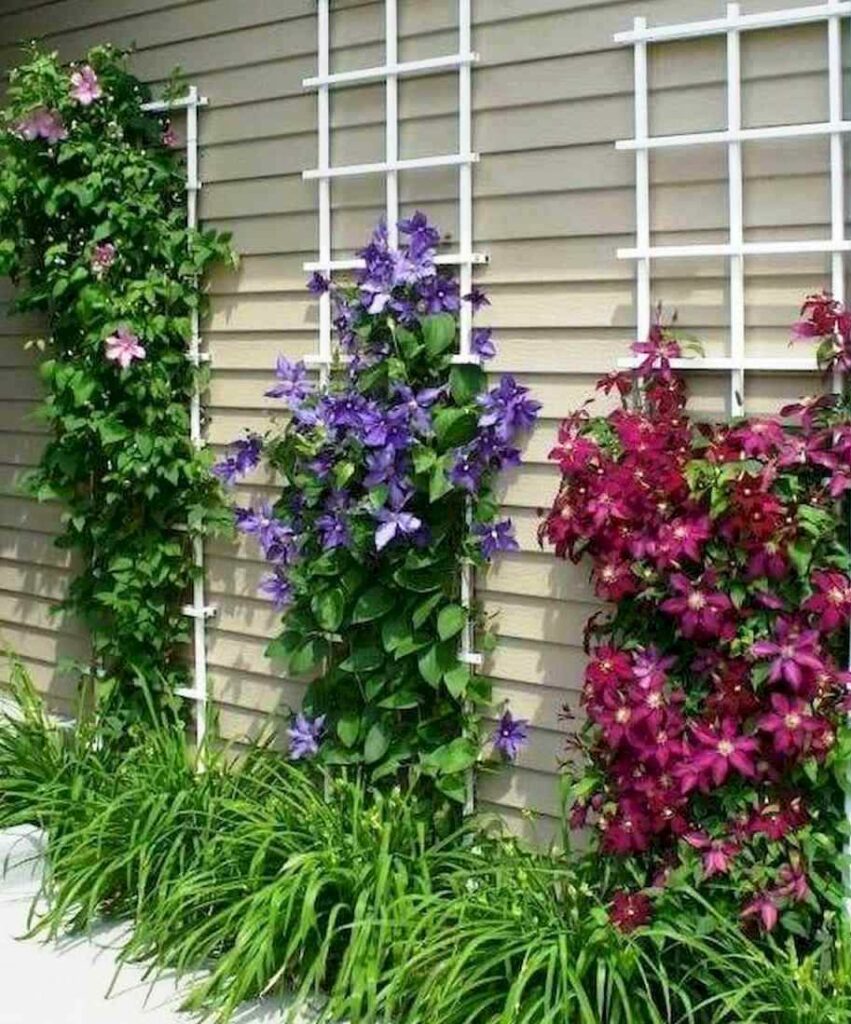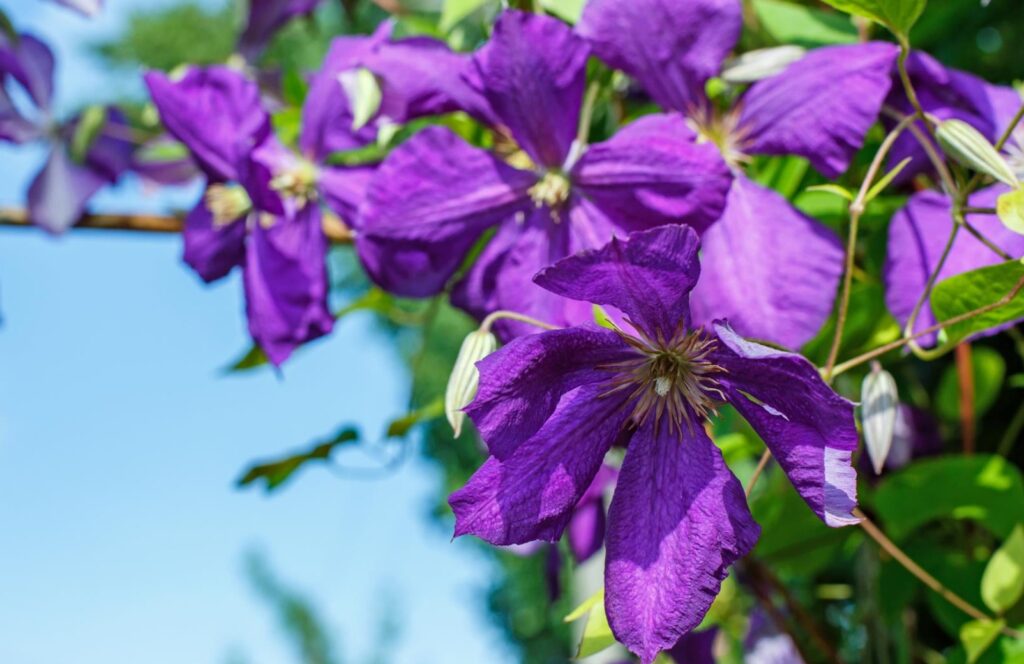by Ken Lain, the mountain gardener

This Vine Is Known for Its Bold, Richly-Colored Flowers

With its big, richly-colored flowers, The President clematis offers great aesthetic value for its looks, alone. But as a fast-growing vine that can be trained to grow up various structures in the landscape, it has many uses that give it even more value. Like other types of clematis, it has some specific care requirements that you must learn so that you can keep your plant happy and healthy. Plant your clematis in late spring, late summer, or early fall. The President is a medium-sized vine.
Botanical Name Clematis ‘The President’
Common Name The President clematis
Plant Type Deciduous, perennial, flowering vine
Mature Size 8-10 ft. tall
Sun Exposure Full to partial sun
Soil Type Well-drained loam
Soil pH Slightly acidic to neutral
Bloom Time May—primary blooming period—till frost
Flower Color Violet-blue
Hardiness Zones 4-8
Native Area North America, Central America, Europe, Asia
Toxicity Toxic to humans, pets, and livestock
Clematis ‘The President’ Care
This climbing vine is a large-flowered variety (6-8 inches in diameter). Showy, spherical, puffy seedheads succeed the blooms in this genus. As a result, you have fall interest long after the blooms have passed.

The cupped flowers of this fast-growing cultivar are a dark violet-blue color. There are typically eight overlapping sepals, which have hints of silver on their undersides. Reddish anthers (part of the stamen, where the pollen comes from) stick out from the center.
Clematis ‘The President’ is considered a “repeat bloomer.” While it is still young, it may bloom in early July and again in September. But a mature plant should start blooming in May and then flower again periodically until the first frost.
Light
At the southern end of its range, filtered sunlight is preferred, lest the rich color of the blooms be cooked off. Full sun is fine in the North, but always keep the roots shaded.
Soil
Locate clematis ‘The President’ in a well-drained loam enriched with compost.
Temperature and Humidity
This popular perennial variety does well in many climates, in most of the United States, coming back every spring and summer after cool or even freezing winters.
Water
Be sure to water when the soil is dry, but do not overwater. Clematis performs best when the soil around its roots is kept evenly moist.
Fertilizer
Non-organic growers supplement (or replace) compost with applications of a commercial balanced fertilizer such as 10-10-10 in spring and summer.
Even in the North, mulch the base of the plant (or otherwise shade the ground from which the plant springs) to keep the roots cool.

Is Clematis ‘The President’ Toxic?
The ASPCA lists clematis as being toxic to pets and livestock. It is also poisonous for humans, according to North Carolina State University. Clematis leaves, flowers, and roots are toxic, and this may be the reason why the vines are deer-resistant plants. Clematis is also one of the rabbit-proof flowers, meaning the furry creatures aren’t interested one lick.
Symptoms of Poisoning
Contact with skin can cause dermatitis for people and animals. Ingesting clematis ‘The President’ can cause stomach upset, vomiting, diarrhea, drooling, and mouth ulcers. Contact either poison control, or your veterinarian, immediately.
Pruning
Clematis ‘The President’ should be pruned right after the first flowering. It is best to prune it every other year.
Propagating Clematis ‘The President’
Clematis ‘The President’ can be propagated with cuttings made from new, green growth. With clean gardening shears, cut a length 1-inch above and below a leaf node. Your cutting only needs one leaf stem, so trim off extras. Dip stems in rooting hormone, shake off excess. Fill small pots with potting mix, and lay the cuttings on top, horizontally. Lightly cover with soil, sprinkle the top with water, and place in a clear plastic bag. Set in bright but not direct light, check for rooting in four weeks by gently tugging on stems.
Rooted cuttings need their own pots, and should be slowly acclimated to the outdoors. It will take a year of light watering and sunlight till they’re ready to be planted in your garden.
How to Grow Clematis ‘The President’ From Seed
According to the International Clematis Society, clematis can be grown from seed but it may take three years for those seeds to germinate. If you insist, collect seeds in the fall and plant in sterile seed mix in plastic containers—like zip top bags—that can be sealed. Water lightly. Place in a cool shady spot, or even your fridge, to mimic seasonal cooling. Then place in the sunlight in warm weather.
Potting and Repotting Clematis ‘The President’
Clematis ‘The President’ can be potted in containers, but they will require more attention than their relatives already in your garden: Plant in large pots, the extra soil will keep the roots protected. Use lightweight potting mix, and attach or install a trellis from the get-go. Water regularly, fertilize in spring and once or twice during the growing season.
Overwintering
Mulch will also help shield your plant from winter’s cold, a fact especially important to remember if you are growing the vine in a container where winters are bad. Some who experiment with growing Clematis ‘The President’ in a pot forget to mulch for winter, and they pay the price, finding out, in spring, that their vine had died over the course of the winter.
Common Pests/Diseases
Slugs are a major pest for clematis, just as they are for hosta. Earwigs can also be a problem. Just as you can trap slugs with beer, so you can trap earwigs with vegetable oil. Simply sink a shallow container into the ground, then add the vegetable oil. The earwigs are drawn to it, tumble in, and drown. The usual advice for dealing with yet another bug problem, spider mite, is to hose down the vines with a strong spray of water, which knocks them off.
But the interaction between these plants and the animal kingdom is not all bad news. For example, they will draw hummingbirds to your yard.

